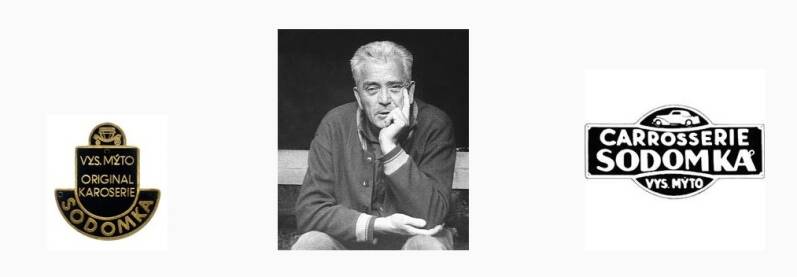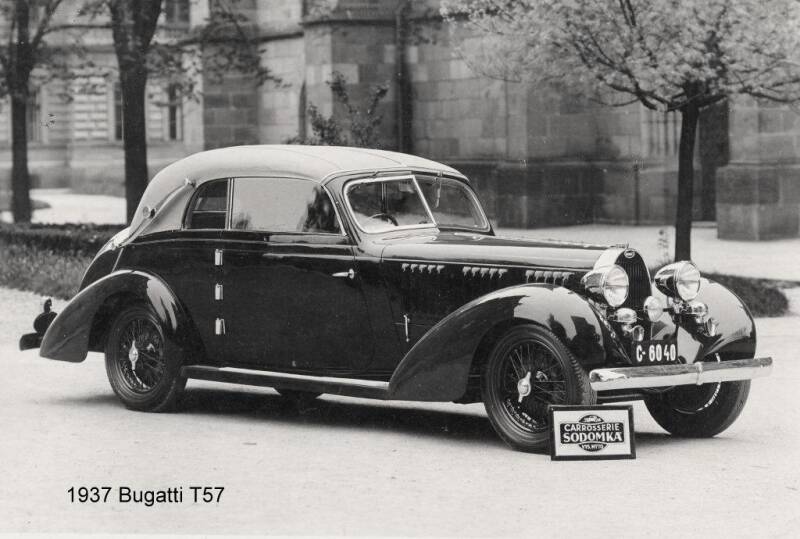Carrosserie Sodomka

Because I love the designs of the Czech coach builder Josef Sodomka (1904-1965), I decided to pay some attention to him by means of this separate chapter. He was appreciated by many in the thirties, but already forgotten in the sixties, let alone in the present time of cluelessness and superficial approach.
Sodomka was born in Vysoké Mýto, East Bohemia, Czechoslovakia, as the son of Josef sr. and Katerina Sodomka. His father had founded his own plant for carriages, wagons and sleighs in 1895. Shortly after the birth of Josef Sodomka jr. the small trades company changed into the first East-Czech locomotive carriage manufacturer.
Sodomka sr. trained his son as a wheelwright and to further deepen his knowledge he went to the school of carriage bodyworks in Kašperské Hory, from which he graduated in 1922. From 1923 until May 1925, Josef Sodomka jr. functioned at the Laurin & Klement car factory at Mladá Boleslav, where he met new trends in design and production of car bodies. This acquired knowledge significantly influenced his orientation towards future production programs of his father’s company.
In June 1925, Sodomka jr. returned to Vysoké Mýto and insisted upon a change over to the design and construction of custom bodies for passenger cars and eventually his father agreed. The first coachwork was an open body on a Praga Mignon chassis. No sheet metal was used, the wooden frame was covered with imitation leather.

After finishing the body of the Praga Mignon and a series of wooden frames for the body of the Praga Piccolo, the program started to develop well. Since 1926, the company was called "Sodomka Body Plant Vys. Mýto". It’s important to note that the design and construction of car bodies was under the immediate influence of Josef Sodomka jr. Technological construction principles from the French company of C.T. Weymann were used. Sodomka didn’t focus only on body design for passenger cars; since 1928 also bodies for buses and utility vehicle were built. Mainly on Skoda, Praga and Walter chassis.
At the end of the twenties there was an increase in demand for luxury convertible-type bodies. Sodomka reacted and made new contacts with vehicle manufacturers. Most important was the experience gained at the Gläser bodyworks at Dresden, which was renowned for the construction of a folding hood mechanism.

In 1930 Sodomka designed his first convertible body type on a Tatra 30 chassis. In subsequent years his convertibles (Tatra, Praga, Walter, Jawa, Aero and many more on foreign chassis such as La Salle, Rolls Royce, Bugatti, Maybach and Lancia) celebrated success, not only with Czechoslovakian customers.

After a property settlement in 1931, Josef Sodomka jr. became the only owner of the company. This enabled him to further develop cooperation and projects. Thanks to his personal contacts with Dr. V. Kabeš from Aero, a close cooperation began with the Aero Praha car company from 1936 on. Sodomka also intended to build a luxury body on an Aero chassis with avant-garde elements in the style of body lines of the French companies Figoni & Falaschi from Boulogne-sur-Seine and Saoutchik. The partial implementation of this intention however occurred all the way in 1939 with the building of car bodies for Aero called the Dynamik. In the same year Josef Sodomka sr. died.

Notwithstanding the economical crisis, the entire thirties were successful for Josef Sodomka in the areas of design and business. His coachwork was in increasing demand and became very elegant. Under his leadership bodies arose for passenger cars, utility vehicles and even buses. Many of them were very bold designs, but not all made it into production (for example the roadster body on the RR Phantom III chassis). Even so called weekend caravans for cars were built and for some time there also was an experimental production of gliders.
New approaches and technologies were reflected by the construction of full metal bodies for buses and a Lancia passenger car as well. In the second half of the thirties, Sodomka’s bodywork plant functioned on an enlarged area of 1922 m2 with improved equipment and there were about 75 employees. Wages and terms of employment were above average. At that time there were about 150 bodywork companies in Czechoslovakia, the Carrosserie Sodomka firm being one of the most important.


Sodomka also built a small series of pedal cars which were ordered by Aero Praha for their customers. One of these pedal cars was showed at the Prague Autoshow in 1937 on the Sodomka exhibition stand. See the picture below, where Josef Sodomka's daughter Hana is at the steering wheel.

A one-off minicar was built by Sodomka in 1939/1940 for his son Josef. It had a similar design as the Aero Dynamik. The 50 cc engine came from a Jawa Robot motorcycle and it had three gears, gas and brake pedals. On the original 1940 photo below is Josef Sodomka jr (6 years old ) at the steering wheel with his friend next to him. The mini car was purchased by Regionalni Muzeum Vysoke Myto in 2011 where it is now exhibited after a renovation.


The establishment of the Protectorate of Bohemia and Moravia led to the suppression of many activities in Sodomka’s bodywork company (such as the design of passenger car bodies), but also to an increasing number of bodies for buses, uitility vehicles and even trailers. The design and construction of a Maybach luxury armoured limousine for the Slovak Minister of Transport and Public Works, Július Stan, however was a prestigious commission for Josef Sodomka and his entire bodywork company in Vysoké Mýto.


After 1945 Sodomka was, apart from leading the company, also interested in other intentions such as the design of a passenger car, the establishment of a bodywork school in Vysoké Mýto and the preparation of special exponents of the company for the XXVIII International Car Show in Paris in 1947.
The company was nationalised by the communists in 1948, the new organisation being called Karosa, into which several coachbuilders were consolidated. Josef Sodomka remained managing director and his activities continued. He was occupied with the design of a convertible body on the Tatra T600 chassis and also other car bodies. The aircooled rear engined Tatra T600 was a unique one-off, which was given to Stalin in 1949 for his 70th birthday. In the nineties the car returned to the Czech Republik and is now in the Tatra-Museum in Kopřivnice.



In November 1950 Josef Sodomka was arrested and charged with allegedly committing economic crime and preparing his emigration. Although charges were later dropped, he was not allowed to return to his original work after he was released in 1952. Since 1953 he was employed at LIAZ in Mnichovo Hradiště as a constructor and test engineer, but he couldn’t carry out independent creative work anymore. LIAZ was a manufacturer of trucks, formed in 1951 by the government as a division of Skoda. The irony of fate was that, although being a recognised coachbuilder, Sodomka could not afford a car to go to work. It is said that instead he used a threewheel Velorex. The years in prison had affected his health and in 1964 he became disabled. After suffering physical and mental hardship, Sodomka died in oblivion on February 9th, 1965 in the hospital at Vysoké Mýto. Of his wife and two children only his daughter Hana is still alive today. She is now the official registered owner of the Carrosserie Sodomka trademark.
In 1994 Karosa became a part of Renault V. I., which itself was in 1999 integrated into the Irisbus holding (since 2003 wholly owned by the Iveco Group). Since then the company is known as IVECO Czech Republic a.s.
Unfortunately most of Sodomka's coachwork has not survived the test of time. Also regrettable is that the majority of the original photos and drawings were destroyed or burned. However the elegance of his custom bodies as preserved by the photographs that still exist will always appeal to us.
Each year some of the few remaining cars are showed during the annual meeting of the "Společnost přátel Carrosserie Sodomka" (friends society Carrosserie Sodomka) in Vysoké Mýto.
See also http://www.sodomka.estranky.cz/
Many photographs of the Sodomka bodied cars, buses, etc. can easily be found through Google pictures http://goo.gl/jWJ1Rs, that's why I have added just a selection here.





















Maak jouw eigen website met JouwWeb